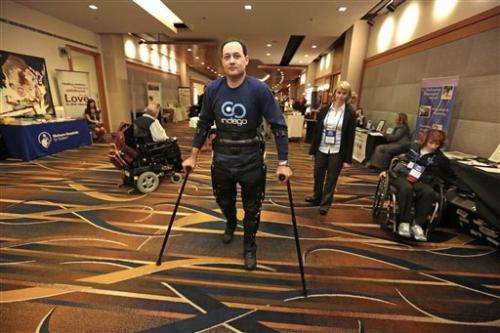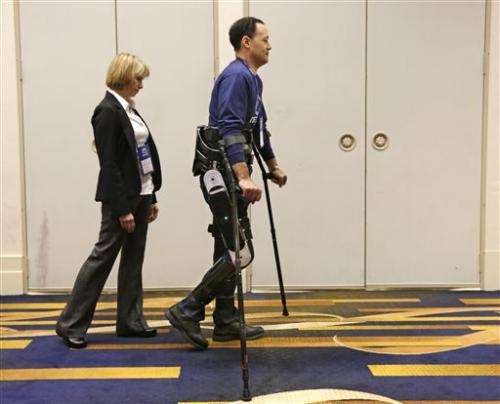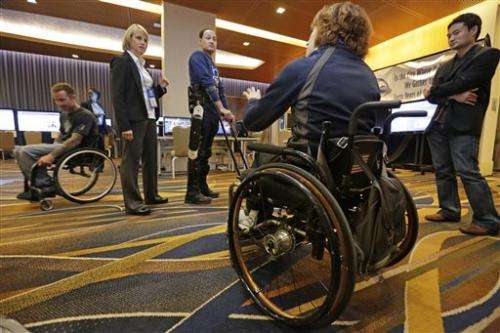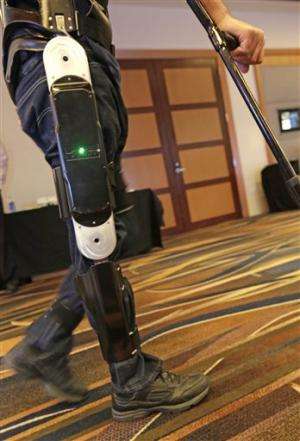Wearable robots getting lighter, more portable

When Michael Gore stands, it's a triumph of science and engineering. Eleven years ago, Gore was paralyzed from the waist down in a workplace accident, yet he rises from his wheelchair and walks across the room with help from a lightweight wearable robot.
The technology has many nicknames. Besides "wearable robot," the inventions also are called "electronic legs" or "powered exoskeletons." This version, called Indego, is among several competing products being used and tested in U.S. rehab hospitals that hold promise not only for people such as Gore with spinal injuries, but also those recovering from strokes or afflicted with multiple sclerosis and cerebral palsy.
Still at least a year away from the market, the 27-pound (12.25-kilogram) Indego is the lightest of the powered exoskeletons. It snaps together from pieces that fit into a backpack. The goal is for the user to be able to carry it on a wheelchair, put it together, strap it on and walk independently. None of the products, including the Indego, are yet approved by U.S.l regulators for personal use, meaning they must be used under the supervision of a physical therapist.
Gore, 42, of Whiteville, North Carolina, demonstrated the device this week at the American Spinal Injury Association meeting in Chicago, successfully negotiating a noisy, crowded hallway of medical professionals and people with spinal injuries in wheelchairs.
When he leans forward, the device takes a first step. When he tilts from side to side, it walks. When Gore wants to stop, he leans back and the robotic leg braces come to a halt. Gore uses forearm crutches for balance. A battery in the hip piece powers the motors in the robotic legs.
"Being able to speak with you eye-to-eye is just a big emotional boost," Gore said to a reporter. "Being able to walk up to you and say hello is not a big thing until you cannot do it."

The devices won't replace wheelchairs, which are faster. None of the devices are speedy enough, for example, for a paralyzed person to walk across a street before the light changes, said Arun Jayaraman of the Rehabilitation Institute of Chicago, who is testing a number of similar devices.
"None of them have fall prevention technology," Jayaraman said. "If the person falls, they can hurt themselves badly. If you fall down, how do you get off a robot that is strapped into you?" They need to be even lighter and have longer-lasting batteries, he said.

Still, Jayaraman said, the devices might help prevent pressure sores from sitting too long in a wheelchair, improve heart health, develop muscle strength, lift depression and ultimately bring down medical costs by keeping healthier patients out of the hospital.
Companies in Israel, New Zealand and California make competing devices, and all the products are becoming less bulky as they are refined. The Indego was invented at Vanderbilt University in Nashville and tested at the Shepherd Center, a rehabilitation hospital in Atlanta. It's now licensed to Cleveland-based Parker Hannifin Corp., which makes precision engineered products like aircraft wheels and brakes.

Like many other research participants in clinical studies, Gore receives a stipend for his participation from Vanderbilt University.
It's unclear exactly how much the devices will cost if they become available for personal use. Some technology news media reports have said $50,000 (€38,000) to $75,000 (€57,000). Indego's makers want to bring the cost below that, said co-inventor Ryan Farris of Parker Hannifin. Experts say it will take years of research to prove health benefits before Medicare and private insurance companies would consider covering the expense.

Paul Tobin, president of the nonprofit advocacy group United Spinal, said wearable robots present an exciting opportunity but that patients should keep their expectations realistic.
"It's going to be critical that people have a thorough medical evaluation before trying something like this, especially if they've been injured for some time," Tobin said. "It won't be appropriate for everyone. For some people, it will be a godsend."
© 2013 The Associated Press. All rights reserved.

















